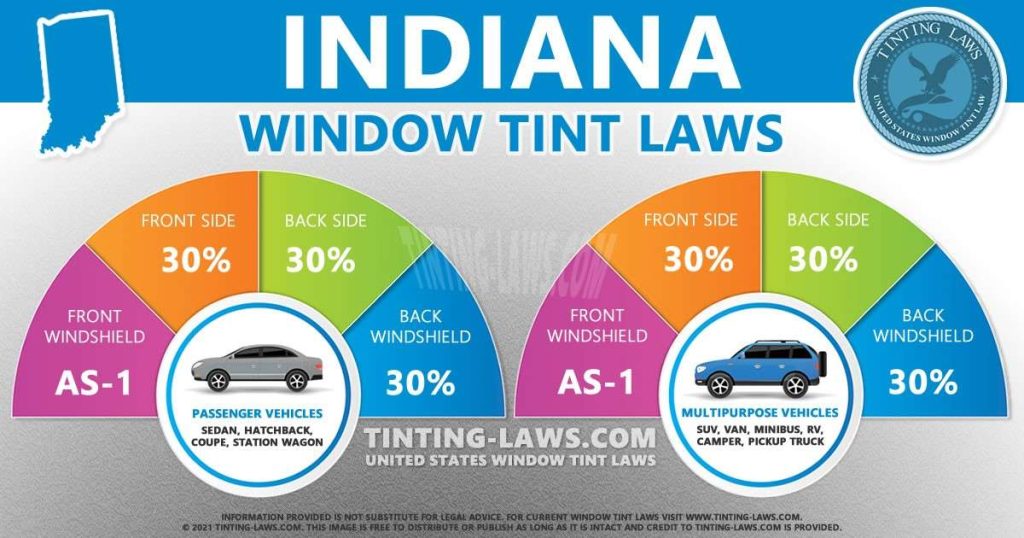Indiana Window Tinting Laws
Car window tinting laws in Indiana were enacted in 2003.
We have provided all the necessary information about your car’s window tint, including how dark or reflective the tint is allowed in your state.
There are also additional car window tinting rules and regulations in Indiana so make sure you read all about it below.
Window tint darkness in Indiana
The percent of visible light allowed through your car windows is called VLT: Visible Light Transmission.
The percentage of light allowed through your film and glass in Indiana is very specific and different for sedan cars and SUV cars or vans.
Tint darkness for sedans:
- Windshield: Non-reflective tint is allowed above the manufacturer’s AS-1 line.
- Front Side windows: Must allow more than 30% of light in.
- Back Side windows: Must allow more than 30% of light in.
- Rear Window: Must allow more than 30% of light in.
Tint darkness for SUV and vans:
- Windshield: Non-reflective tint is allowed above the manufacturer’s AS-1 line.
- Front Side windows: Must allow more than 30% of light in.
- Back Side windows: Any darkness can be applied several (unspecified) inches from the top of the window.
- Rear Window: Any darkness can be applied several (unspecified) inches from the top of the window.
Window tint reflection in Indiana
Window tint can reflect incoming light and reduce glare and heat.
Indiana window tint law permits a certain window reflection when using a tint so make sure you pay attention to this as well.
Tint reflection for sedans:
- Front Side windows: Must not be more than 25% reflective.
- Back Side windows: Must not be more than 25% reflective.
Tint reflection for SUV and vans:
- Front Side windows: Must not be more than 25% reflective.
- Back Side windows: Must not be more than 25% reflective.
Other Indiana window tint rules and regulations:
Indiana does have several other important laws, rules and regulations pertaining to window tinting. They include the following:
- Side Mirrors: No restrictions.
- Restricted Colors: No colors of tint are explicitly banned in Indiana state.
- Certificates: Manufacturers of film need to certify the film they sell in Indiana. Ask your dealer if they are using certified film.
- Stickers: No sticker to identify legal tinting is required.
- Medical Exceptions: Indiana state allows medical exemptions for special tint.
- Penalties: Class A or Class C infraction.
Keep in mind that Indiana tinting laws and regulations may be interpreted differently in your county or place of residence.
We always recommend double-checking our information with your local DMV or law enforcement authorities.

Our information about window tint laws in Indiana was last updated in 2024.
Tinting laws in Indiana were enacted in 2003.
In case any of our info provided is not up to date or correct be sure to contact us so we can fix it. Thanks!
Trusted industry leader in providing accurate window tint laws. Share with confidence:
State of Indiana Info
Indiana is a U.S. state located in the midwestern and Great Lakes regions of North America.
Indiana is the 38th largest by area and the 16th most populous of the 50 United States.

Indiana is the least extensive state in the contiguous United States west of the Appalachian Mountains.
Its capital and largest city is Indianapolis. Indiana was admitted to the United States as the 19th U.S. state on December 11, 1816.
Capital: Indianapolis
Population: 6,537,334
Area: 36,418 sq mi (94,321 km2)
Cities in Indiana: Indianapolis, Fort Wayne, South Bend, Evansville, Bloomington, Gary, Terre Haute, Muncie, Carmel, Lafayette, Fishers, Kokomo, Elkhart, Noblesville, Michigan City, Columbus, Mishawaka, Merrillville, Avon, Valparaiso, West Lafayette, French Lick, Crown Point, Hammond, Anderson, Shipshewana, Richmond, New Albany, Greenwood, Goshen, Marion, Madison, Zionsville, Warsaw, Nashville, New Harmony, Broad Ripple, Brownsburg, Santa Claus, Jeffersonville, Vincennes, Wakarusa, Plainfield, Greenfield, Popcorn, La Porte, Westfield, Munster, Crawfordsville, Portage
Counties in Indiana: Adams, Allen, Bartholomew, Banton, Blackford, Boone, Brown, Carroll, Cass, Clark, Clay, Clinton, Crawford, Daviess, Dearborn, Decatur, DeKalb, Delaware, Dubois, Elkhart, Fayette, Floyd, Fountain, Franklin, Fulton, Gibson, Grant, Greene, Hamilton, Hancock, Harrison, Hendricks, Henry, Howard, Huntington, Jackson, Jasper, Jay, Jefferson, Jennings, Johnson, Knox, Kosciusko, LaGrange, Lake, LaPorte, Lawrence, Madison, Marion, Marshall, Martin, Miami, Monroe, Montgomery, Morgan, Newton, Noble, Ohio, Orange, Owen, Parke, Perry, Pike, Porter, Posey, Pulaski, Putnam, Randolph, Ripley, Rush, St. Joseph, Scott, Shelby, Spencer, Starke, Steuben, Sullivan, Switzerland, Tippecanoe, Tipton, Union, Vanderburgh, Vermillion, Vigo, Wabash, Warren, Warrick, Washington, Wayne, Wells, White, Whitley
Tint law references:
Indiana Code Title 9, Article 19, Chapter 19: Windows and Windshield Wipers